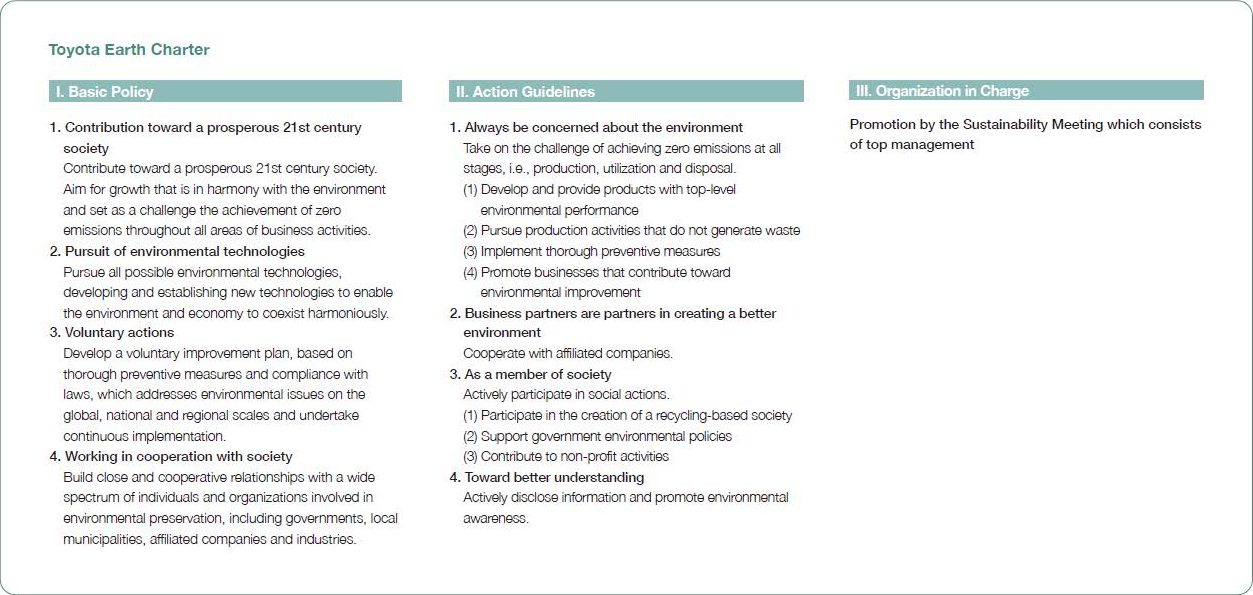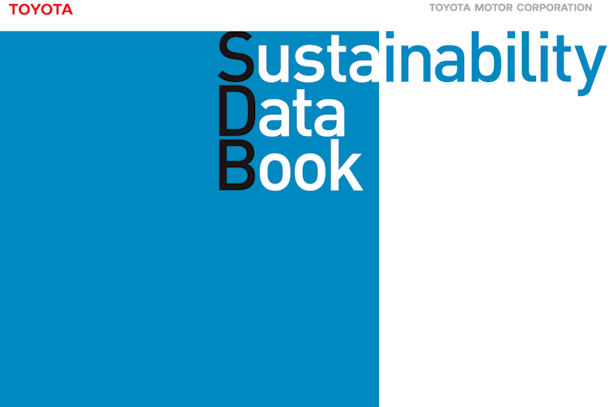Policy
Aim
- Reduce the environmental footprint and contribute to the sustainable development of society and the world throughout all areas of our business activities.
- Build close, cooperative relationships with a wide spectrum of individuals and organizations involved in environmental preservation.
Initiative
Toyota Earth Charter
- Conducting continuous environmental initiatives since the 1960s.
- Established the Toyota Earth Charter in 1992 (revised in 2000).
- Formulated our long-term initiatives for the global environment by 2050 as the Toyota Environmental Challenge 2050, in 2015*. Subsequently advancing various initiatives centered on this.
| * | 2015The 21st session of the Conference of the Parties to the United Nations Framework Convention on Climate Change (COP21) was held this year. |
|---|
Toyota Earth Charter
Toyota established the Toyota Earth Charter in 1992 and promoting environmental initiatives.
Toyota Environmental Challenge 2050
Toyota announced the Toyota Environmental Challenge 2050 in 2015.
In order to address global environmental issues such as climate change, water shortage, resource depletion and loss of biodiversity, Toyota is promoting measures based on these six challenges, aiming to reduce the negative environmental impacts of manufacturing and driving vehicles as close to zero as possible and to make net positive impacts on society.
Initiatives
Toyota is committed to reducing its environmental impact and contributing to the sustainable development of society and the Earth through all areas of its business activities. We will promote initiatives to cope with climate change, to contribute to resource recycling, and to coexist in harmony with nature.
Toyota's Perspective on Public Policy
Toyota's mission, as defined by the Toyota Philosophy, is "Producing Happiness for All", and the vision is "Creating Mobility for All". We have always been committed to contribute to the overall good, so our approach to business is in line with the vision of the 17 Sustainable Development Goals (SDGs). Our perspective on public policy flows from our desire to do good for society.
The role of government and public policy is critical to helping reduce the effects of climate change and promote expansion of advanced technology vehicles around the world. Toyota seeks to ensure that public policy, societal needs, technology development, and consumer needs are aligned to the greatest extent possible.
As a member of society in the countries and regions in which we operate, we believe it's a privilege and a responsibility to contribute to public policy by sharing our technical and consumer knowledge, our vision and our views. Toyota does this transparently and always in full accordance with the spirit and letter of the law. We have positive relationships with governments and their administrative agencies, regulators, mainstream major political parties, non-profit organizations, local communities, customers, dealers, suppliers, and employees. We show respect to all, consistent with a core company belief and therefore hope to become a company that is respected and welcomed by all.
Contributing to society and public policy means that Toyota places a high priority on participating and influencing activities through industry and other associations. For example, many Toyota executives and employees are currently participating in various associations across the globe and are involved in contributing to their public policy advocacy.
Toyota's Views on Climate Public Policies
We have summarized our views on key climate related policies, our views on public policies, and the industry associations to which we belong. Toyota does so to be more transparent about our activities, to build and increase trust with the public, and to further strengthen cooperation between all stakeholders.
Validation and approval of Toyota's emissions reduction targets by the Science Based Targets initiative (SBTi*1)
Toyota's emissions reduction targets for Scope 1 and 2 and Scope 3 Category 11*2 were validated and approved*3 by SBTi in September 2022 as follows:
| Emissions | Target year | Base year | Reduction rate | Validation / Approval class | |
|---|---|---|---|---|---|
| Scope 1 and 2 | 2035 | 2019 | 68% | 1.5℃ | |
| Scope 3 Category 11 (emission intensity) | |||||
| Passenger light duty vehicles and light commercial vehicles | 2030 | 33.3% | Well Below 2℃ | ||
| Medium and heavy freight trucks | 11.6% | ||||
| *1 |
|
|---|---|
| *2 |
|
| *3 |
|





